How to Grow Carrots for Beginners
This article will walk you through How to Grow Carrots for Beginners, from planting, watering, mulching, and harvesting. Gardening 101 help that you can use to grow vegetables in your own backyard, starting with carrots!
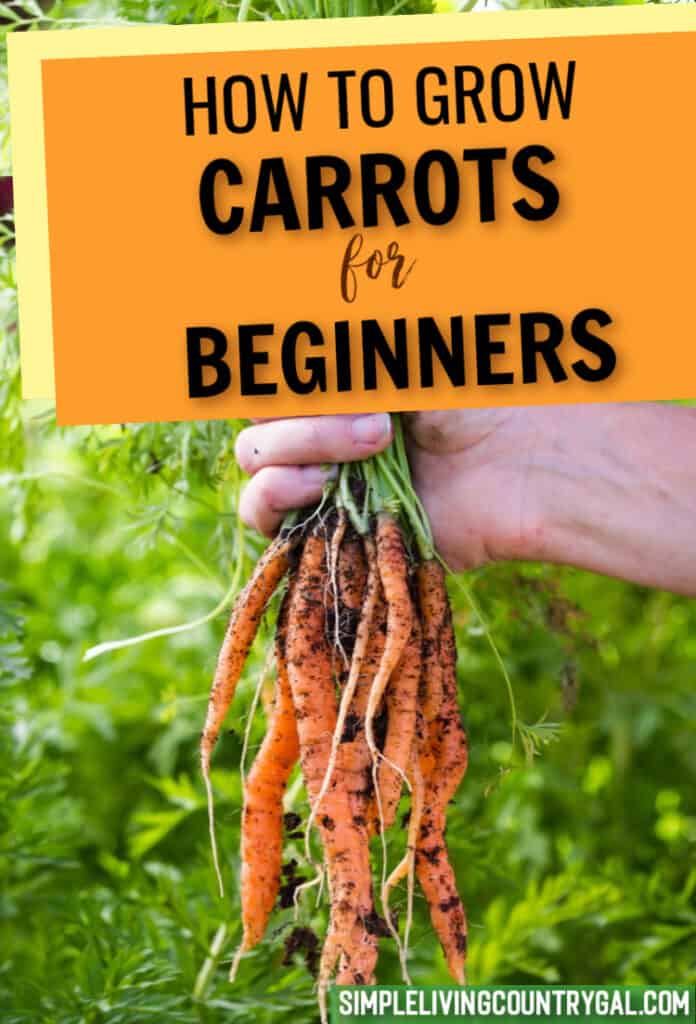
Even though carrots are a little tricky to plant, they are super easy to grow, and because of that, it is a great crop for beginner gardeners.
The most important thing you need to know before planting your carrots is they are a root crop and that means you will need to have loose, sandy soil for those roots to really do well. If your soil is clumpy, full of clay, or has rocks, you’ll want to do some work to prepare your garden for planting. For us, that means raised beds.
Our soil is so full of clay it really is the easiest way to create better growing conditions for not only our carrots but many other root crops as well.
READ: SQUARE FOOT GARDENING AKA RAISED BED GARDENING
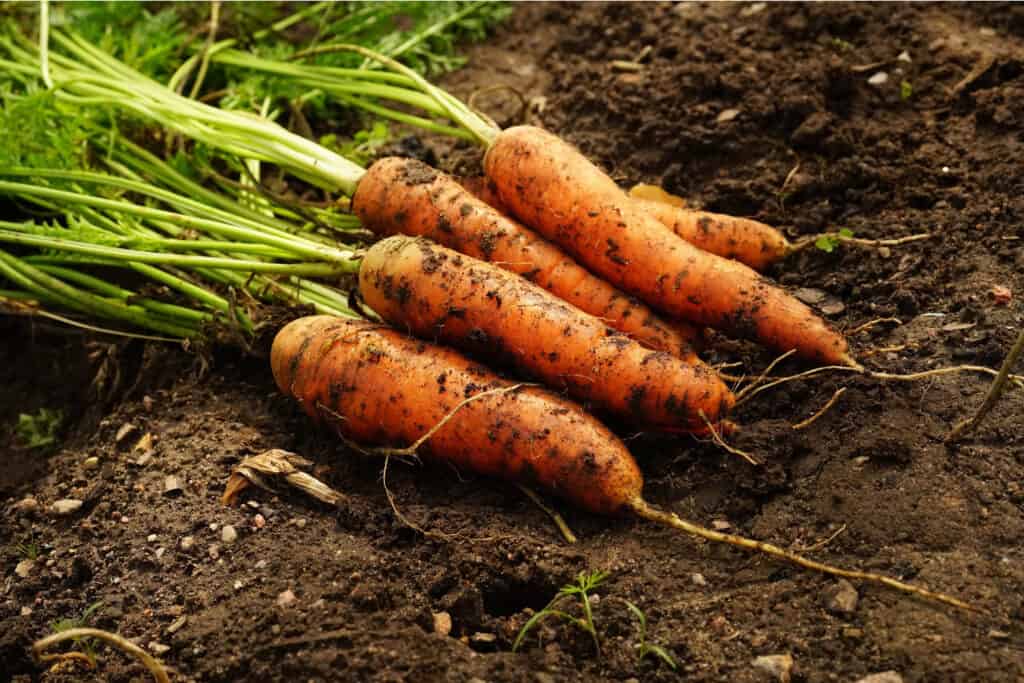
This guide on how to grow carrots for beginners will tell you everything you need to know to get started and grow a full, healthy crop for harvesting.
Growing Carrots – What to Know
In addition to being an easy crop, carrots can grow through most of the year which means they can withstand a frost. Carrots take about 70-80 days to grow and be ready for harvesting. If you love carrots you can stagger your plants so you have a lovely and continuous harvest through the fall.
For a summer harvest, you’ll want to plant 3-5 weeks before the last spring frost and for a fall harvest, plant mid- to late-summer beginning about 10 weeks before the first frost of the fall. If you want a continually growing harvest, plant a new round of seeds about every 3-4 (staggering) weeks through late spring or early summer.
There are several varieties of carrots that you can choose for your garden:
- Nantes – these carrots are perfectly cylindrical from the top to the bottom and they have a sweet flavor. They are fairly low maintenance.
- Imperator – these are the ones most commonly seen in grocery stores. They have a higher sugar content than other varieties so they’re a bit sweeter.
- Chantenay – If you don’t have the right soil conditions for other varieties, you can still grow these. They’ll grow well in heavy soil, growing 6-7 inches long. Just be sure to harvest as soon as they’re ready. If they stay in the ground too long, they’ll lose some flavor.
- Danvers – these long, skinny carrots grow well in various soil conditions, even clay soil. While they’re mostly orange, they also grow in other colors.
- Mini Carrots – unlike the mini carrots you see in the grocery store that have been shaved down from full-size carrots, there are varieties of carrots that grow smaller, some even as small as radishes. These varieties tend to be sweeter and because they’re so small, they do better in containers.
What You Need to Grow Carrots
When it comes to growing carrots, there are a few things you’ll need: good soil, space, and lots of sun. There are also a few bonuses to growing carrots that make them easy for beginner gardeners. They can withstand a frost so they can be planted early, before the last frost of the year, and can continue to grow through the first frost of the fall.
They are ready to harvest in about 2 months from planting so you can continue to plant seeds throughout the season and continue to harvest.
The soil is one of the most important factors to growing carrots; it can’t be hard or rocky. You’ll need to prepare the soil before planting with a hoe and/or a rake to break up any clumps and dig out any rocks. The soil will need to have a sand-like texture to grow healthy, hearty carrots.
In addition to good soil, you’ll need to choose an area in your garden that will receive 6-8 hours of sunlight daily. Carrots can tolerate partial shade, but they grow better in direct sunlight.
Lastly, you’ll need some space. Carrots need to be about 2-3 inches apart in rows that are 16-24 inches apart to give them room to grow nice and hearty. Because the seeds are so tiny, you can plant seeds closer together, even in clumps, then thin them out as they grow. You can also purchase carrot seed tapes or seed dispensers to help with planting. I have used both and find the seed tapes to be much easier to use.
To produce enough carrots for your family, you’ll need about 48 plants per person, which means you’ll need a lot of room.
How to Grow Carrots in a Garden
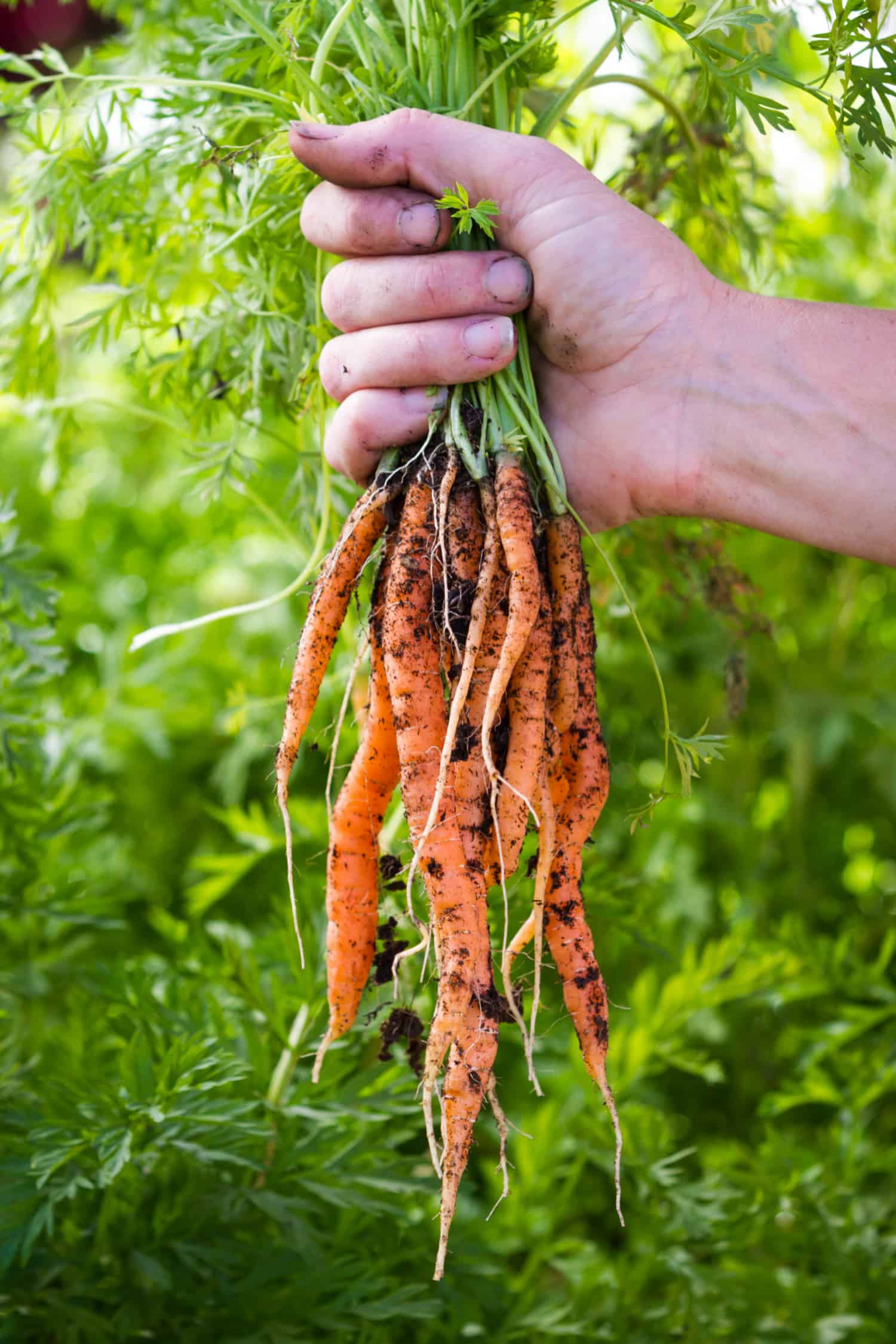
As we talked about earlier, it is important to prepare your soil before planting. You can do this by clearing any rocks and raking the soil to remove any clumps making the area lighter and ready for planting.
After preparing the soil, use a hoe to make a line or row that is about ¾” deep. Before planting you will want to water it first before laying in the seeds or seed tape. Finally, sprinkle a little multi-purpose compost along the soil to help the seeds germinate.
Now you’re ready to plant. There are two schools of thought on seed planting. One is to plant fewer seeds further apart to avoid needing to thin the plants out later. And the other is to plant seeds in larger groups to help them germinate then thin them out after they start to grow. If you choose this method, the plants will need to be thinned to 12 plants per foot in a row.
Be aware though, when planting seeds close together it can sometimes attract carrot flies which can cause grubs to grow and tunnel into the roots.
Once planted, you will only need to slightly push to soil back over the line of seeds to gently cover them. If there are clumps, try to break them up with your hands so there’s just a fine covering of soil over the seeds then gently press it down. Finally, gently water the top of the soil with a watering can or light mist hose sprayer.
SLCG PRO TIP: Because carrot seeds are so small, gentle is the key, especially in the beginning. Keep things in place with soil and water, and watch until you see those seeds begin to sprout. As your carrots grow they will get stronger, and you can then allow them to coast a bit from there.
It will take a couple of weeks to start seeing the sprouts pop through the soil, be patient and keep them watered. Remember that if you planted your seeds closely, you’ll need to do some thinning out after they sprout.
How to Plant Tiny Carrot Seeds
If you haven’t planted carrots before when you first open the package of seeds you may be wondering how you’ll ever be able to plant just a few because they’re so tiny it’ll be hard to grab just a couple.
Tiny carrot seeds tend to clump together and they’re dark so when you lay them in the soil, you can’t see where they’re resting. This means you run the risk of planting too many in one area and will need to thin them out when they sprout.
You can get a little more control over the number of seeds you plant at once by using tweezers or a small spoon to get just a few at a time.
The other option is to plant pellet seeds. These seeds are bigger and white so you can easily see them when they’re resting in the soil and you can be more intentional about spacing them out.
You can also use a seed planter or seed tape to really make the planting process easier.
Temperature
Carrots grow best in the warmer months, spring, summer, and fall, but they can withstand a frost or two so you can plant them in early spring and continue to grow them through late fall depending on the temperatures in your region.
Sun
Carrots like full, direct sunlight, preferably 6-8 hours per day. While they will still grow in partial shade or with fewer hours of sun, they’ll grow larger and you’ll have a fuller crop if they get direct sunlight.
Soil
Carrots need well-tilled, stone-free soil that has a sandy texture. Hoe and/or rake the soil before planting to loosen clumps and remove rocks. They also like a little compost, which you can lay in the soil before laying your seeds.
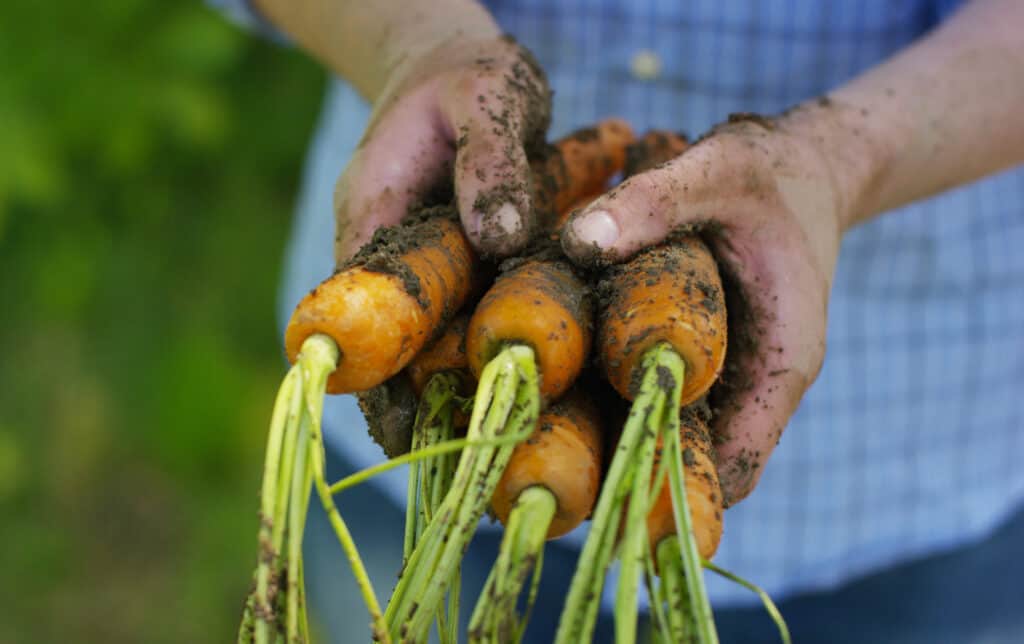
Fertilizing
Carrots are one of the few vegetables that don’t like to be fertilized. Avoid using fertilizer in your soil because if the soil is too fertile, the root will fork and the carrots won’t grow as big.
How Many Seeds to Plant
To have plenty of carrots to feed your family and possibly have some for canning, you’ll need about 48 plants per person in your household. With spacing them 2-3 inches apart in rows about 16-24 inches apart, that means you’ll need a lot of space for carrot plants.
Spacing
When planting, you can space your seeds a little closer, about an inch apart, until they start to sprout, but then you’ll need to thin them out to give them plenty of room to mature. For the best growth and to allow your carrots to grow big, once they sprout, you’ll want 2-3 inches between each plant.
Depth
Carrot seeds don’t need to be planted deep; the carrot will push its way into the soil as it grows. Plant your seeds about 1/4 – 1/2 inch deep and place a layer of compost in the trench before laying seeds.
Growing Tips for Carrots
- Using a tool like tweezers or a spoon will help you plant the dark, tiny seeds without getting them too close together.
- Remember that your plants need about 2-3 inches between them to grow healthy so you’ll need to thin them out once they sprout. Do this by snipping them at ground level instead of pulling them out; this will prevent damage to the roots of the remaining plants.
- Carrots need plenty of water, at least 1 inch every week. Keep the soil moist but not too wet with frequent, shallow waterings. To test if the soil is wet enough, stick your index finger into it; it should be moist up to an inch deep.
- Carrots can take 2-3 weeks to start sprouting so don’t worry if you don’t see any signs of life right away.
- Gently mulch around the carrots to help retain water in the warmer months and speed germination. This will also block the sun from directly hitting the roots.
- When weeding, be careful not to disturb the roots of the young carrot plants.
Deter Rabbits and Deer
Deer and rabbits love carrot plants. Not only will they eat the green sprouts growing above the soil, they’ll dig up growing carrots from the soil for snacking. To keep them from enjoying all of your carrots:
- Place chicken wire or some other fencing around your garden to help keep them out.
- Use all-natural deterrents, which you can find at most gardening center, to help keep them away from your plants.
When to Harvest Carrots
Pull carrots from the soil when they are 1 – 1 ½ inches in diameter. Generally speaking, the smaller the carrot the better they taste. Carrots should be about as wide as your thumb before harvesting. Try to harvest in the morning hours before it gets too hot. The heat can cause the roots to become fibrous.
Carrots tend to taste better after a frost or two, it encourages the plant to start storing energy (sugar) for later. After the first hard frost of the fall, cover the tops with about 18 inches for shredded leaves if you plan to harvest later. This will protect the plants while still allowing them to grow.
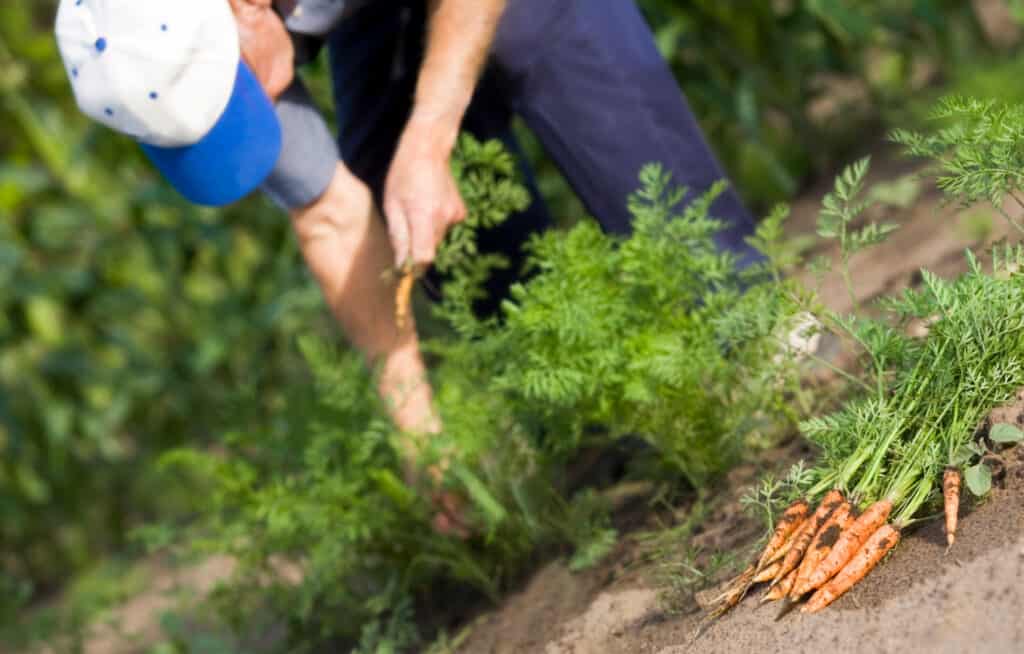
How to Store Carrots
To store your freshly harvested carrots for later, twist off or cut the tops, scrub off any remaining dirt under cold water, and let them air dry. Once dry, store them in airtight plastic bags and put them in the refrigerator. If you put them directly in the refrigerator from harvesting, they’ll go limp fairly quickly.
You can also leave mature carrots in the ground a little longer if cold weather and pests aren’t a problem. Or you can store them in tubs with moist sand or dry sawdust in a cool, dry area.
Carrots are an easy crop for beginner gardeners. They don’t take a lot of work and they have a longer growing season than many other vegetables. If you have plenty of space, can prepare your soil well, and make sure they get plenty of sun and water, you’ll enjoy carrots for several months of the year.
Get creative with all the carrots from your garden. Make carrot ginger soup, carrot casserole, or souffle, or use them to bake a delicious carrot cake. You’re certain to find a number of ways you like to enjoy your harvest.
